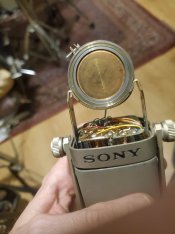Hi,
I have a faulty Sony C-38b condenser.
At the "M" mode the signal is very low and it's getting very low and then stronger from time to time.
In all the other modes there's a very weak signal with almost no low frequencies.
I replaced all the electrolytic caps on both boards and in the dc to dc converter.
I also replaced R1 since it measured as a capacitor instead of a resistor.
I took some voltage readings and it seems like some of the voltages are a little bit higher and some of them are a little bit lower than the schematic.
There's a way to determine if it's a case of a dead capsule or something with the electronics?
I have a faulty Sony C-38b condenser.
At the "M" mode the signal is very low and it's getting very low and then stronger from time to time.
In all the other modes there's a very weak signal with almost no low frequencies.
I replaced all the electrolytic caps on both boards and in the dc to dc converter.
I also replaced R1 since it measured as a capacitor instead of a resistor.
I took some voltage readings and it seems like some of the voltages are a little bit higher and some of them are a little bit lower than the schematic.
There's a way to determine if it's a case of a dead capsule or something with the electronics?









